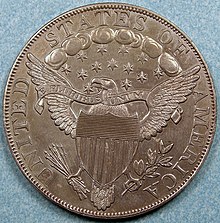1804 silver dollar
| United States | |
| Value | 1 U.S. dollar |
|---|---|
| Mass |
Class I: 410.21 grains (26.581 g)–416.4 grains (26.98 g) Class II: 381.5 grains (24.72 g) Class III: 402.8 grains (26.10 g)–416.25 grains (26.973 g) |
| Diameter | 39-40 mm (1.53-1.57 in) |
| Edge |
Class I: HUNDRED CENTS ONE DOLLAR OR UNIT Class II: Plain Class III: HUNDRED CENTS ONE DOLLAR OR UNIT |
| Composition | 90.0% Ag 10.0% Cu |
| Obverse | |
 |
|
| The obverse of a Class I 1804 dollar | |
| Design | Bust of Liberty, facing to the viewer's right, with the date and the word "LIBERTY" |
| Design date | 1795 |
| Reverse | |
 |
|
| The reverse of a Class I 1804 dollar | |
| Design | Heraldic representation of an eagle holding a scroll reading "E PLURIBUS UNUM", above which are 13 stars and clouds, with "UNITED STATES OF AMERICA" along the periphery |
| Design date | 1798 |
The 1804 dollar or Bowed Liberty Dollar was a dollar coin struck by the Mint of the United States, of which fifteen specimens are currently known to exist. Though dated 1804, none were struck in that year; all were minted in the 1830s or later. They were first created for use in special proof coin sets used as diplomatic gifts during Edmund Roberts' trips to Siam and Muscat. Some silver dollars were struck in 1804, though all were dated 1803. In 1806, production was suspended by order of James Madison, then Secretary of State, and the denomination was not struck again until the 1804-dated pieces were minted.
Edmund Roberts distributed the coins in 1834 and 1835. Two additional sets were ordered for government officials in Japan and Cochinchina, but Roberts died in Macau before they could be delivered. Besides those 1804 dollars produced for inclusion in the diplomatic sets, the Mint struck some examples which were used to trade with collectors for pieces desired for the Mint's coin cabinet. Numismatists first became aware of the 1804 dollar in 1842, when an illustration of one example appeared in a publication authored by two Mint employees. A collector subsequently acquired one example from the Mint in 1843. In response to numismatic demand, several examples were surreptitiously produced by Mint officials. Unlike the original coins, these later restrikes lacked the correct edge lettering, although later examples released from the Mint bore the correct lettering. The coins produced for the diplomatic mission, those struck surreptitiously without edge lettering and those with lettering are known collectively as "Class I", "Class II" and "Class III" dollars, respectively.
From their discovery by numismatists, 1804 dollars have commanded high prices. Auction prices reached $1,000 by 1885, and in the mid-twentieth century, the coins realized over $30,000. In 1999, a Class I example sold for $4.14 million, then the highest price paid for any coin. Their high value has caused 1804 dollars to be a frequent target of counterfeiting and other methods of deception.
...
Wikipedia
